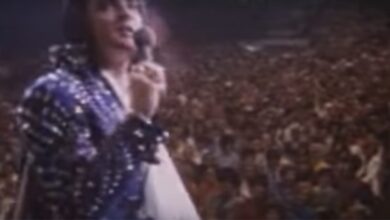The Emotional Duet Of “Don’t Cry Daddy” By Elvis And Lisa Marie Presley Might Bring Tears To Your Eyes
“Don’t Cry Daddy” is a poignant country ballad that first graced the music scene with Elvis Presley’s emotive rendition in 1969. The song, penned by the talented Mac Davis, intricately weaves a narrative filled with sorrow, grief, and the longing for solace. It tells the heart-wrenching tale of a father attempting to comfort his children, who are dealing with the profound loss of their mother. The lyrics reveal a landscape of sadness, yet they also convey subtle messages of hope and resilience, illustrating the enduring strength of familial bonds even in the face of tragedy. Elvis’s emotional delivery and genuine connection to the song’s themes not only showcased his exceptional vocal talent but also his ability to resonate with the human experience, making “Don’t Cry Daddy” a memorable piece in his extensive catalog.
Elvis Presley, widely revered as the King of Rock ‘n’ Roll, was born in 1935 in Tupelo, Mississippi. His rise to fame began in the mid-1950s, during which he revolutionized the music industry with his electrifying performances and innovative sound. While primarily associated with rock music, Elvis’s repertoire embraced a variety of genres, including country, blues, and gospel. His unique style and charismatic stage presence made him a cultural icon and an enduring figure in the music industry. The ballad “Don’t Cry Daddy” exemplifies this versatile approach, allowing Presley to delve into the emotive depths of country music while still maintaining his rock roots.
In 1997, “Don’t Cry Daddy” saw a remarkable revival through a posthumous duet featuring Lisa Marie Presley, Elvis’s daughter. This collaboration was made possible by advanced digital technology, allowing her voice to be mixed seamlessly with her father’s original performance. The emotional gravity of the song took on a new dimension as their voices intertwined, creating a heartfelt tribute that bridged the gap between generations. Through digital innovation, the past was brought into a contemporary light, allowing listeners to experience a deeply personal connection that transcends time.
Lisa Marie Presley, born in 1968, emerged as an artist in her own right, navigating a musical career that, while linked to her legendary father, carved out a unique identity. Her participation in the duet added an intimate layer to “Don’t Cry Daddy,” emphasizing the intricate bond between a father and daughter. The collaboration highlighted not only her musical heritage but also her emotional investment in the song’s poignant storyline, adding depth and authenticity to the narrative of loss and remembrance.
The duet stands as more than just a familial collaboration; it serves as a tribute to Elvis Presley’s lasting legacy and musical impact. As listeners hear both Elvis and Lisa Marie’s voices resonate together, the emotional depth of the song is amplified, evoking a sense of nostalgia and reflection. Each note delivered by Lisa Marie serves to underscore the profound connection they shared, reinforcing themes of love, loss, and the healing power of music.
To create the posthumous duet, meticulous care was taken to utilize innovative digital techniques that matched Lisa Marie’s vocal performance with her father’s, ensuring that the original recording’s authenticity was preserved. This technical feat required a detailed understanding of the original song’s arrangement and the ability to blend the two distinct vocal styles seamlessly. The outcome is a hauntingly beautiful performance that captures the essence of both artists, resonating with fans who appreciate the width and breadth of their shared musical legacy.
“Don’t Cry Daddy” continues to exemplify the emotional potency of music, serving as a vehicle for connection across different eras of listeners. This duet not only rejuvenates the classic song but also demonstrates how technology can facilitate the preservation of musical heritage, allowing new generations to discover and engage with timeless music. The collaboration between father and daughter acts as a poignant reminder of the beliefs in family and continuity, encapsulating the transcendent nature of art.
Furthermore, the song’s enduring appeal lies in its universal themes that resonate with listeners of all ages. The struggle to cope with loss and the quest for hope in difficult times are experiences that connect people regardless of their backgrounds. “Don’t Cry Daddy” encapsulates these emotions in a manner that is both relatable and deeply affecting. As such, the duet with Lisa Marie not only revives Elvis’s heartfelt craftsmanship but also invites new audiences to reflect on their personal stories and relationships.
In examining the broader impact of “Don’t Cry Daddy,” one can appreciate the role that Elvis Presley played in shaping the landscape of modern music. His ability to traverse various musical styles paved the way for future artists, demonstrating that emotional storytelling is a central component of effective songwriting. The song, along with its posthumous revival, serves as a reminder of how powerful music can be in conveying the complexities of life, love, and loss.
In conclusion, the posthumous duet of “Don’t Cry Daddy” reflects the emotional weight of its origins while celebrating the legacy of Elvis Presley. It encapsulates the enduring bond between father and daughter, illustrating how modern technology can breathe new life into beloved songs, fostering connection and appreciation among fans young and old. This beautiful collaboration transcends time, proving that great music has the capacity to touch our hearts in ways that words alone may not convey.





